For the 2025 school year, there are 4 public schools serving 1,080 students in Pima Unified District (4220) School District. This district's average testing ranking is 4/10, which is in the bottom 50% of public schools in Arizona.
Public Schools in Pima Unified District (4220) School District have an average math proficiency score of 24% (versus the Arizona public school average of 35%), and reading proficiency score of 28% (versus the 41% statewide average).
Minority enrollment is 33% of the student body (majority Hispanic), which is less than the Arizona public school average of 66% (majority Hispanic).
Overview
This School District
This State (AZ)
# Schools
4 Schools
2,476 Schools
# Students
1,080 Students
1,124,009 Students
# Teachers
75 Teachers
50,048 Teachers
Student : Teacher Ratio
14:1
14:1
District Rank
Pima Unified District (4220) School District, which is ranked within the bottom 50% of all 607 school districts in Arizona (based off of combined math and reading proficiency testing data) for the 2021-2022 school year.
The school district's graduation rate of 85-89% has stayed relatively flat over five school years.
Overall District Rank
#397 out of 631 school districts
(Bottom 50%)
(Bottom 50%)
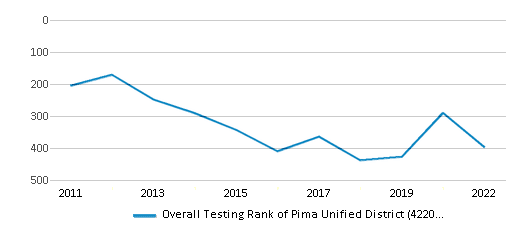
Math Test Scores (% Proficient)
24%
35%

Reading/Language Arts Test Scores (% Proficient)
28%
40%
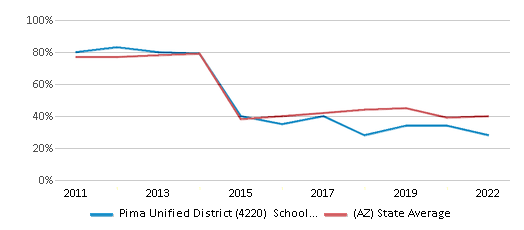
Science Test Scores (% Proficient)
18%
24%
Graduation Rate
85-89%
77%
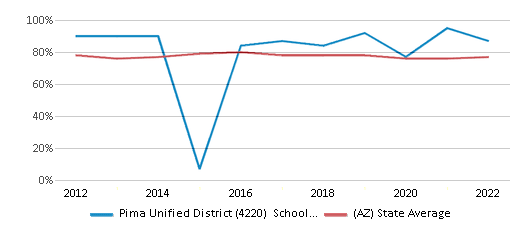
Students by Ethnicity:
Diversity Score
0.47
0.66
# American Indian Students
17 Students
55,943 Students
% American Indian Students
1%
5%
# Asian Students
n/a
35,951 Students
% Asian Students
n/a
3%
# Hispanic Students
320 Students
537,792 Students
% Hispanic Students
30%
48%
# Black Students
12 Students
64,758 Students
% Black Students
1%
6%
# White Students
724 Students
377,234 Students
% White Students
67%
34%
# Hawaiian Students
n/a
4,018 Students
% Hawaiian Students
n/a
n/a
# Two or more races Students
7 Students
48,280 Students
% of Two or more races Students
1%
4%
Students by Grade:
# Students in PK Grade:
-
20,586
# Students in K Grade:
68
73,171
# Students in 1st Grade:
69
78,842
# Students in 2nd Grade:
75
82,537
# Students in 3rd Grade:
70
80,342
# Students in 4th Grade:
83
82,920
# Students in 5th Grade:
80
83,092
# Students in 6th Grade:
73
83,167
# Students in 7th Grade:
97
84,224
# Students in 8th Grade:
95
85,183
# Students in 9th Grade:
102
89,727
# Students in 10th Grade:
102
92,689
# Students in 11th Grade:
84
90,220
# Students in 12th Grade:
82
96,766
# Ungraded Students:
-
543
District Revenue and Spending
The revenue/student of $11,351 in this school district is less than the state median of $11,421. The school district revenue/student has declined by 9% over four school years.
The school district's spending/student of $13,085 is higher than the state median of $11,323. The school district spending/student has declined by 9% over four school years.
Total Revenue
$12 MM
$12,837 MM
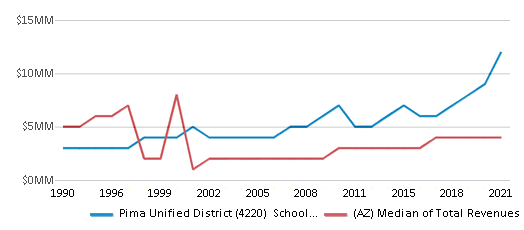
Spending
$14 MM
$12,727 MM
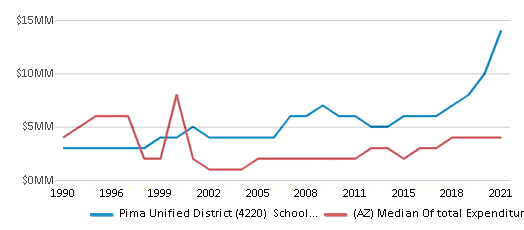
Revenue / Student
$11,351
$11,421
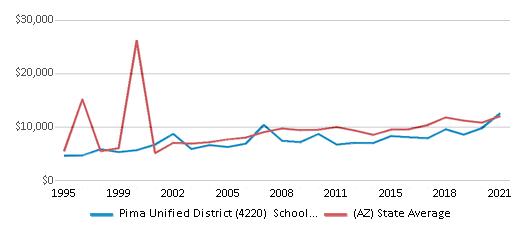
Spending / Student
$13,085
$11,323

Best Pima Unified District (4220) School District Public Schools (2025)
School
(Math and Reading Proficiency)
(Math and Reading Proficiency)
Location
Grades
Students
Rank: #11.
Gila Valley Learning Center
(Math: <50% | Reading: <50% )
Rank:
Rank:
7/
Top 50%10
170 S. Main Street
Pima, AZ 85543
(928) 387-8015
Pima, AZ 85543
(928) 387-8015
Grades: 9-12
| 19 students
Rank: #22.
Pima High School
(Math: 35-39% | Reading: 25-29%)
Rank:
Rank:
5/
Bottom 50%10
131 S. Main
Pima, AZ 85543
(928) 387-8151
Pima, AZ 85543
(928) 387-8151
Grades: 9-12
| 351 students
Rank: #33.
Pima Elementary School
(Math: 23% | Reading: 31%)
Rank:
Rank:
4/
Bottom 50%10
131 S. Main Street
Pima, AZ 85543
(928) 387-8051
Pima, AZ 85543
(928) 387-8051
Grades: K-6
| 518 students
Rank: #44.
Pima Junior High School
(Math: 20-24% | Reading: 20-24%)
Rank:
Rank:
4/
Bottom 50%10
192 E. 200 S.
Pima, AZ 85543
(928) 387-8101
Pima, AZ 85543
(928) 387-8101
Grades: 7-8
| 192 students
Frequently Asked Questions
How many schools belong to Pima Unified District (4220) School District?
Pima Unified District (4220) School District manages 4 public schools serving 1,080 students.
What is the rank of Pima Unified District (4220) School District?
Pima Unified District (4220) School District is ranked #387 out of 607 school districts in Arizona (bottom 50%) based off of combined math and reading proficiency testing data for the 2021-2022 school year.
What is the racial composition of students in Pima Unified District (4220) School District?
67% of Pima Unified District (4220) School District students are White, 30% of students are Hispanic, 1% of students are American Indian, 1% of students are Black, and 1% of students are Two or more races.
What is the student/teacher ratio of Pima Unified District (4220) School District?
Pima Unified District (4220) School District has a student/teacher ratio of 14:1, which is lower than the Arizona state average of 18:1.
What is Pima Unified District (4220) School District's spending/student ratio?
The school district's spending/student of $13,085 is higher than the state median of $11,323. The school district spending/student has declined by 9% over four school years.
Recent Articles

Year-Round Or Traditional Schedule?
Which is more appropriate for your child? A year-round attendance schedule or traditional schedule? We look at the pros and cons.

Why You Should Encourage Your Child to Join a Sports Team
Participating in team sports has a great many benefits for children, there is no doubt. In this article you will learn what those benefits are.

White Students are Now the Minority in U.S. Public Schools
Increasing birth rates among immigrant families from Asia and Central and South America, combined with lower birth rates among white families, means that for the first time in history, public school students in the United States are majority-minority. This shift in demographics poses difficulties for schools as they work to accommodate children of varying language abilities and socio-economic backgrounds.





